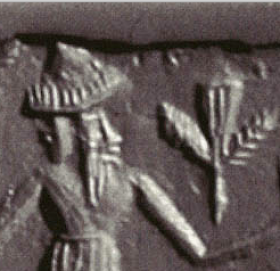To the right of the first figure is the symbol for grain.
So this is grain field ploughing...We find this symbol in Indus Valley civilisation artefacts too...
This is the end of the "normal" and "expected" stuff on this seal. The rest is...Well mythology...
Or is it?
The plough is pulled by, what is commonly interpreted as, a snake or a dragon. I would say dragon. Under the dragon is a lion. Above the dragon is a scorpion.
Why?
Well it's all about solar zodiac, again. On that climatic, biological (not stellar) zodiac, animals are used to mark significant reoccurring events in the solar year. Like a lifecycle event of that animal, which happens every year at the same time and which everyone knows about.
For instance lion marks the time when Eurasian lions main mating season starts:
And scorpion marks the time when Eurasian scorpions "disappear" (start hibernating, hide from cold), which happens in late October early November...
You can read more about solar zodiac here.
What does this have to do with ploughing of grain fields in Mesopotamia? Well according to their agricultural calendar:
1. The first ploughing of the barley fields was done in August-September. During Leo...
2. The second ploughing+sowing was done in October-November. During Scorpio...
Neat, right? But what about the dragon pulling the plough?
Well, the climatic year in Mesopotamia is divided into two parts: Dry season from May to October and Wet(er :)) season from November to April.
Now the dry part of the year, summer-autumn, starts in Taurus. Taurus is where it is in the Solar zodiac, because it marks the beginning of the calving season of the Eurasian wild cattle. You can read more about this here.
Well, normally Mesopotamian seals depicting ploughing show ploughs being pulled by oxen, bulls.
Is this why bull was replaced by a dragon as the animal pulling the plough? To indicate that the first ploughing was to be done at the of maximum droughts, symbolised by raging bull/dragon?
All of this accidentally :) happens in Leo...
I am not sure...This dragon thingy is quite puzzling alright...
Now here is something very interesting. Star Sirius is positioned right above the plough. Why?
In the second part of the 3rd millennium BC, the time when this seal was made, Sirius was rising in Iraq in in the morning before the sunrise, in Leo, at the time of the first ploughing. And it was setting in Iraq in the morning before the sunrise in Scorpio, at the time of the second ploughing and sowing...
Now I used Stellarium computer simulation program for these calculations...If they are correct, and I don't doubt they are, this explains why Sirius is positioned right above the plough...And this is truly amazing...
And it reads:
Plough the fields first time when lions start mating...And Sirius is rising before the sun...
Plough the field second time and sow the fields when scorpions disappear...And Sirius is setting before the sun...
Well maybe, or maybe this is all just mythology...Gods, monsters...
Just to add some more detail. In Mesopotamia people used two types of ploughs.
The ploughing plough :) used in Leo for breaking the soil.
The Sowing plough, used in Scorpio for furrowing, sowing and covering
And just to see that I am not just inventing stuff here, here is another seal, showing sowing plough used in Scorpio...
Is that Sirius again above the plough?
I wonder what birds are flying all around...
I think this is a common crane.
The common crane lives in Northern Eurasia, but winters in Southern Asia and North Africa, Including Mesopotamia.
According to "Cranes of the World: Eurasian Crane (Grus grus)" by Paul A. Johnsgard, Cranes gather in huge numbers in Eastern Turkey in late September early October, from where they fly down to the marshlands of Mesopotamia...Right in time for sowing...
I wonder what birds are flying all around...
I think this is a common crane.
The common crane lives in Northern Eurasia, but winters in Southern Asia and North Africa, Including Mesopotamia.
According to "Cranes of the World: Eurasian Crane (Grus grus)" by Paul A. Johnsgard, Cranes gather in huge numbers in Eastern Turkey in late September early October, from where they fly down to the marshlands of Mesopotamia...Right in time for sowing...
















4000 BC - 2000 BC was the age of Taurus. The spring equinox occurred in the constellation of the bull. It would be confusing to have the symbol for Spring pulling your plough. Could be disastrous.
ReplyDeleteThe summer solstice was located in the constellation of Leo, and the fall equinox was in the constellation of Scorpio.
Did you not read the article at all? Have I mentioned constellations anywhere? The behavior of animals doesn't change within the solar year and the same things happen every year at the same time...This is not under the influence of precession...Only under the influence of the sun and local climate, which is what the farmers care about really. They don't give a f... about any other star very much...
DeleteCould you add any sources from this please, Im using this topic for a major History Work and would be super helpful :)
ReplyDeleteThe analysis is my original work. You can read more about animal and plant calendar markers mentioned here in many other posts on my blog. I believe that all the external refs are in the doc.
Delete